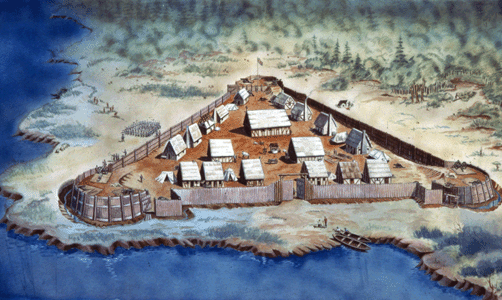Jamestown Bones Prove Colonial-Era Cannibalism
May 7, 2013
Grisly proof that the colonists of Jamestown (in what is now Virginia) resorted to cannibalism to survive the terrible winter of 1609-1610 has been unveiled by forensic anthropologists at the Smithsonian Institution’s National Museum of Natural History in Washington, D.C. Smithsonian scientists displayed the skull and tibia (lower leg bone) of a young girl, nicknamed Jane, that were excavated from a trash-filled corner of historic Jamestown in 2012 by archaeologists with the Jamestown Rediscovery Project. On the skull, they saw telltale cuts and other damage indicating that the girl’s body was crudely butchered to be eaten.

Jamestown as it may have appeared in 1608. The English settlers built a triangular fort to protect themselves from Indians. (© Hulton Archive/Getty Images)
Jamestown, the first permanent English settlement in North America, was founded in 1607 when colonists from England established themselves on an uninhabited peninsula about 60 miles (97 kilometers) from the entrance of the Chesapeake Bay. The settlers made themselves secure by building a triangular fort at the site. However, the Jamestown site was swampy and unsuitable for raising crops. The arrival of more colonists during 1608 and 1609 led to steadily worsening relations with the nearby Powhatan Indians. By winter, war had begun and the Powhatan surrounded Jamestown in an effort to starve the colony into submission.
Jamestown’s population dropped from about 250 to 60 during this so-called Starving Time of 1609-1610, as settlers struggled to survive the seige despite insufficient food. Written records describe how the desperate colonists ate horses, cats, dogs, rats, and even shoe leather. Historians have long known of some accounts that hinted at cannibalism by the colonists. But without physical proof, many scholars dismissed the accounts.
Smithsonian forensic anthropologists pointed out that Jane’s skull shows several parallel cuts made by a sharp metal knife on the forehead, cheek and jaw. Archaeologists are familiar with such defleshing marks, as they are typically found on animals that were butchered for meat. The back of Jane’s skull was split open with an ax or cleaver, and a puncture mark indicates a knife blade was used to pry apart the bones of her skull.
The skull damage and depth of the cuts suggest the work of a hesitant and inexperienced butcher, so Smithsonian scientists do not believe Jane was intentionally killed to be eaten. They speculate that she may have been one of many colonists who arrived in 1609 and later died of starvation or disease during the harsh winter siege.
Forensic anthropologists were able to create a reconstruction of what Jane may have looked like. They determined Jane’s age, sex, and ancestry by examining the skeletal remains. Computed tomography (CT) scans of the skull enabled scientists to fill in missing pieces and create a virtual 3-dimensional model. Demographic analysis showed that her teeth and the shape of her skull are characteristic of an English female about 14 years old. The scientists guessed that she may have had fair skin and light eyes based on English portraits from the 1600′s. A sculptor used this information combined with a detailed knowledge of facial anatomy to create a bust of Jane as she likely appeared shortly before her death.
Additional World Book articles:
- Archaeology
- Anthropology
- Colonial life in America
- Rediscovering Jamestown on its 400th anniversary (Special report)


